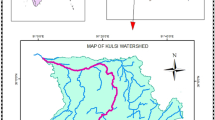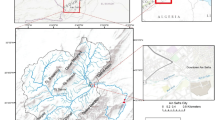Abstract
This study describes the application of distributed hydrologic model, KIneMatic wave STOrm Runoff Model (grid-based KIMSTORM) to simulate the flood discharge considering dam releases during storm event. The model adopts single flowpath algorithm, and simulates surface and subsurface water depth by routing the water balance of hydrologic components at each cell. For the 12,373 km2 watershed having four dams (two multipurpose, one hydroelectric, and one flood regulation) of NamHan river in Korea, the model was calibrated and verified at five stream locations (two on main and three on tributary) for six flood events with the average Nash–Sutcliffe model efficiency of 0.77. The release amount from dam cell was successfully delivered to the next down cell as an inflow and propagated to the downstream because the model solves the flow routing with hydrologic approach. From the spatiotemporal model results, we could trace the growth of overland flow discharge, the flood flow progress, and the regulation effect by the dams.









Similar content being viewed by others
References
Beasley DB, Huggins LF, Monke EJ (1980) ANSWERS: a model for watershed planning. Trans ASAE 23(4):938–944
Bell VA, Kay AL, Jones RG, Moore RJ (2007) Development of a high resolution grid-based river flow model for use with regional climate model output. Hydrol Earth Syst Sci 11:532–549
Beven KJ (1982) On subsurface stormflow: predictions with simple kinematic theory for saturated and unsaturated flows. Water Resour Res 18:1627–1633
Chow VT, Maidment DR, Mays LW (1988) Applied hydrology. McGrawHill, New York
Grayson RB, Moore ID, McMahon TA (1992) Physically based hydrological modeling: 1. A terrain-based model for investigative purposes. Water Resour Res 28(10):2639–2658
Huggins LF, Monke EJ (1968) A mathematical model for simulating the hydrologic response of a watershed. Water Resour Res 4(3):529–539
Jinkang D, Shunping X, Youpeng X, Chong-yu X, Singh VP (2007) Development and testing of a simple physically-based distributed rainfall-runoff model for storm runoff simulation in humid forested basins. J Hydrol 336:334–346
Jung IK, Lee MS, Park JY, Kim SJ (2008) A Modified grid-based KIneMatic wave STOrm Runoff Model (ModKIMSTORM), I. Theory and model. KSCE J Civ Eng 28(6):697–707
Jung IK, Park JY, Park GA, Lee MS, Kim SJ (2011) A Grid-based rainfall-runoff model for flood simulation including paddy fields. Paddy Water Environ 9(3):275–290
Kim SJ (1998) Grid-based KIneMatic Wave STOrm Runoff Model (KIMSTORM): I. Theory and Model. J Korea Water Res Assoc 30(3):303–308
Kim SJ, Steenhuis TS (2001) GRISTORM: grid-based variable source area storm runoff model. Trans ASAE 44(4):863–875
Kim SJ, Chae HS, Shin SC (1998) Grid-based KIneMatic Wave STOrm Runoff Model (KIMSTORM): II. Application—applied to Yoncheon Dam watershed. J Korea Water Res Assoc 30(3):309–316
King KW, Arnold JG, Bingner RL (1999) Comparison of Green-Ampt and curve number methods on Goodwin creek watershed using SWAT. Trans ASAE 42(4):919–925
Luo Q (2007) A distributed surface flow model for watersheds with large water bodies and channel loops. J Hydrol 337:172–186
Mein RG, Larson CL (1973) Modeling infiltration during a steady rain. Water Resour Res 9(2):384–394
Nash JE, Sutcliffe JV (1970) River flow forecasting through conceptual models: Part I—a discussion of principles. J Hydrol 10:283–290
Rawls WJ, Brakensiek DL, Saxton KE (1982) Estimation of soil water properties. Trans ASAE 25:1316–1328
Sloan PG, Moore ID (1984) Modeling subsurface stormflow on steeply sloping forested watersheds. Water Resour Res 20(12):1815–1822
Takasao T, Shiiba M (1988) Incorporation of the effect of concentration of flow into the kinematic wave equations and its application to runoff system lumping. J Hydrol 102(1):301–322
Takeuchi J, Kawachi T, Unami K, Maeda S, Izumi T (2009) A distributed hydro-environmental watershed model with three zoned cell profiling. Paddy Water Environ 7:33–43
Vieux BE (2004) Distributed hydrologic modeling using GIS, 2nd edn. Kluwer, Dordrecht
Acknowledgments
This research was supported by a grant from a Strategic Research Project (Development of Flood Warning and Snowfall Estimation Platform using Hydrological Radars) funded by the Korea Institute of Construction Technology.
Author information
Authors and Affiliations
Corresponding author
Rights and permissions
About this article
Cite this article
Jung, IK., Lee, DR., Park, JY. et al. Application of distributed KIneMatic wave STOrm Runoff Model (KIMSTORM) for flood simulation considering dam release in the NamHan river basin of Korea. Paddy Water Environ 13, 167–177 (2015). https://doi.org/10.1007/s10333-014-0418-2
Received:
Revised:
Accepted:
Published:
Issue Date:
DOI: https://doi.org/10.1007/s10333-014-0418-2




